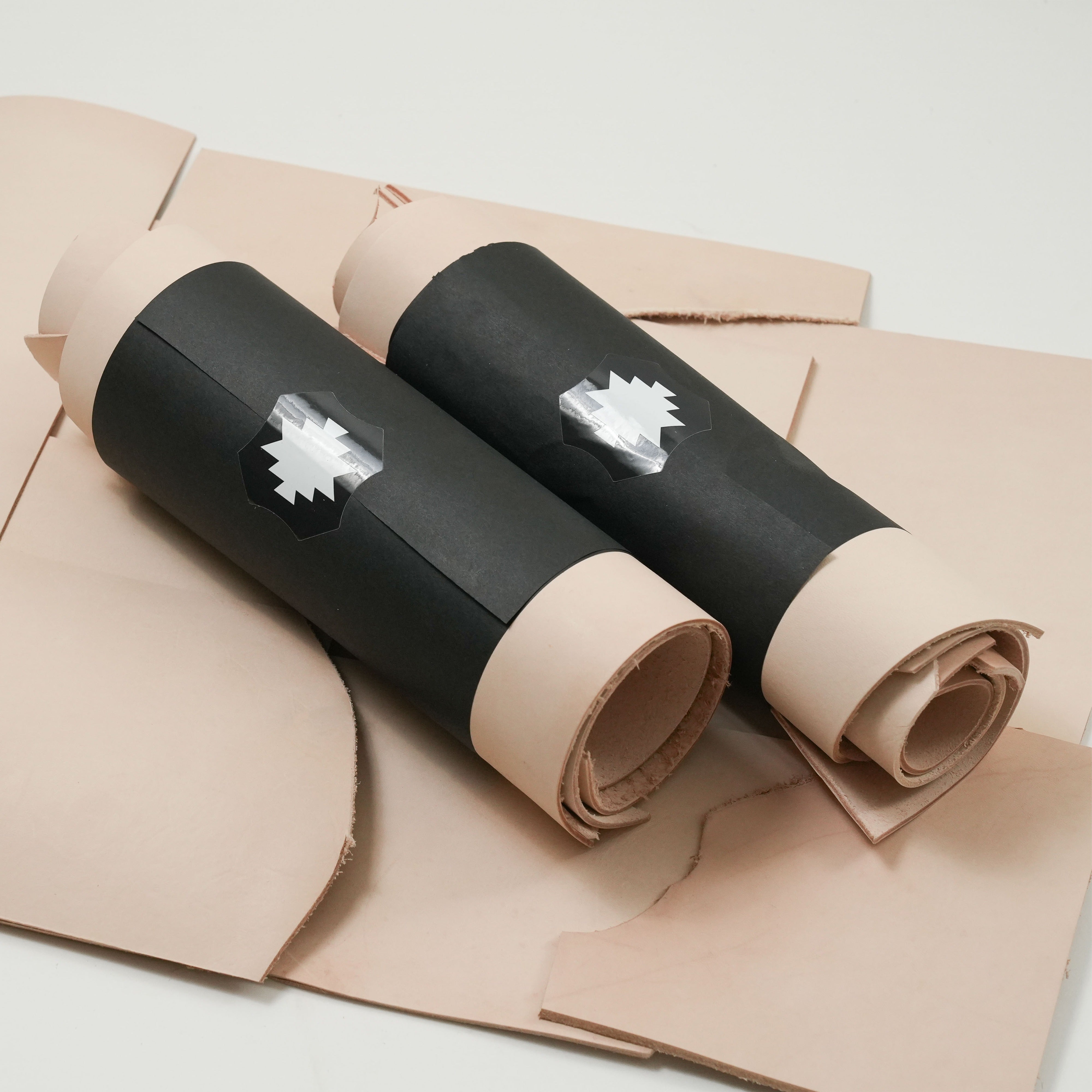
How to Select the Right Vegetable-Tanned Leather for Crafting Projects
Walking into a leather supplier's warehouse can feel overwhelming when you're faced with stacks of hides in different weights, tempers, and finishes. But here's the thing about vegetable-tanned leather; it's the gold standard for crafters because it accepts tooling beautifully, ages gracefully, and responds to your hands like no other material.
The secret to successful leather crafting lies in matching the right hide to your specific project. Whether you're just starting your leather crafting adventure or you've been working with hides for years, understanding these selection criteria will transform how you approach every project. Let's break down exactly what you need to know to choose vegetable-tanned leather like a pro.
Essential Factors When Selecting Vegetable-Tanned Leather
Think of selecting leather like choosing the right canvas for a painting. You wouldn't use watercolor paper for an oil painting, and you shouldn't use soft garment leather for a structural project.
Hide Cut & Grade
The part of the animal your leather comes from makes a huge difference in how it behaves. Now, let's talk about where on the animal your leather comes from.
- The back and leather sides give you the most consistent fiber structure and largest usable area. These sections are perfect for belts, bags, and any project where you need strength and uniformity.
- Shoulder leather tends to be a bit softer and more pliable, making it great for curved projects or items that need to flex.
- Belly leather is the most stretchy and irregular, it's often less expensive but requires more skill to work with effectively.
Leather Thickness (Weight/Ounces)
Leather thickness gets measured in ounces, and this might seem confusing at first. One ounce equals about 1/64 of an inch, so 8-ounce leather is roughly 1/8 inch thick. This measurement directly affects how your leather behaves during crafting.
- Lighter weights (2-3 oz leather) bend easily and work well for wallets, card holders, and linings. They're easy to stitch by hand and won't bulk up your finished piece.
- Medium weights (5-6 oz leather) hit the sweet spot for most projects, thick enough for structure but still manageable for detailed work.
- Heavy weights (8+ ounces) are your go-to for belts, holsters, and anything that needs serious durability.
Here's something many beginners don't realize: thicker leather isn't always better. If you're making a wallet with multiple layers, using 8-ounce leather throughout will create a bulky mess that won't fold properly. But that same thickness is perfect for a belt that needs to hold its shape under stress.
Leather Temper (Firmness & Flexibility)
Temper describes how firm or soft your leather feels, and it's one of the most important factors for tooling and carving projects. Firm temper leather holds crisp lines and sharp details when you're carving, but it can be challenging to work with if you need curves or flexibility. Soft temper leather bends easily and works well for bags or curved projects, but it won't hold fine tooling details as well.
The magic happens when you case your vegetable tanned leather, that's the process of dampening it with water before tooling. Firm leather becomes workable when properly cased, allowing you to create detailed impressions that will hold their shape as the leather dries. Soft leather, when cased, becomes almost moldable, perfect for forming over shapes or creating three-dimensional projects.
Most suppliers will let you feel samples before buying, and this hands-on test tells you more than any description. Press your thumb into the leather; firm temper will resist, while soft temper will give way easily.
Surface & Finish Options
The surface of vegetable-tanned leather greatly affects how it takes dye and how your finished piece looks and feels. For tooling, dyeing, and carving, leather with a smooth, natural grain surface is ideal, it absorbs dyes evenly and retains fine detail.
Some vegetable-tanned leathers are pre-dyed or oil-treated at the tannery. These can offer a rich, ready-to-use look and feel, but they come with trade-offs: pre-dyed leather limits your ability to customize color, while oil-treated leather may resist tooling or unevenly absorb dyes due to the waxes and oils in the surface.
For full creative control, many crafters prefer natural, undyed veg-tan leather, it starts pale and neutral, making it easy to finish, dye, stamp, and carve as desired.
Project-Specific Vegetable-Tanned Leather Selection Guide
Different projects have different demands, and understanding these requirements upfront prevents costly mistakes. Let's walk through the most common leather crafting projects and what each one needs.
Tooling & Carving Projects
For tooling and carving, the leather should have enough thickness to take impressions and hold detail. Vegetable-tanned leather in the 4–5 oz, 5–6 oz, or 8-9 oz range is commonly used, depending on the depth and style of work.
Look for a smooth, natural surface and a medium to firm temper. Medium temper is easier to work with and still holds detail well, while firm temper provides more resistance for deeper cuts and crisp impressions.
Avoid any leather with heavy oils or waxes, these finishes prevent proper casing and make it impossible to get clean impressions. Stick with reputable tanneries that specialize in tooling leather, as they understand the specific requirements for this type of work.
Belts & Straps
Leather for belts needs to be tough enough to handle daily wear while maintaining its shape over time. You're looking at 8–10 oz vegetable-tanned leather with a firm temper, ideally cut from the back or shoulder of the hide for maximum strength and consistency.
For lighter-duty straps or decorative purposes, 5–6 oz leather can also be used — it’s easier to work with and still holds up well under moderate use.
Full-grain leather is preferred because it holds up better and develops a rich patina over time. In contrast, lower-grade or heavily corrected grain leather may be prone to cracking or peeling with heavy use.
Small Leather Goods: Wallets, Pouches, and Accessories
Smaller items require different considerations than structural pieces. You want leather thin enough to avoid bulk but thick enough to provide durability. Most leather for wallets falls in the 2-6 oz range, with medium temper that's easy to fold and stitch.
For lined wallets, consider using different weights for different components, thicker leather for the main body and thinner leather for interior pockets and card slots. This approach gives you structure where you need it without creating unnecessary bulk.
Molding and Holster Leather: Wet-Forming Requirements
Wet-forming projects like holsters or formed sheaths need leather that can hold its shape after being molded while wet. Look for 7-9 ounce leather with firm temper that will maintain its form as it dries.
The key here is finding leather that becomes pliable when wet but firms up nicely as it dries. Some leather becomes too soft when wet and won't hold complex shapes, while others remain too rigid to form properly. Testing a small piece first can save you from ruining an entire hide.
How to Evaluate Vegetable-Tanned Leather Quality
Smart leather crafters test before they commit to large purchases. Most suppliers will sell small samples or allow you to examine leather before buying. Here's what to look for during your evaluation.
The feel test tells you about temper and quality. Press the leather between your fingers, it should feel substantial without being overly stiff. Bend a corner gently; quality leather will flex without cracking or showing stress marks.
For the moisture test, place a small drop of water on an inconspicuous area. The water should absorb slowly and evenly. If it beads up and rolls off, the leather has too much oil or wax for most crafting purposes. If it soaks in immediately, the leather might be too dry or porous.
Color testing matters if you plan to dye your leather. Apply a small amount of dye to a hidden area to see how it absorbs and what the final color looks like. Some leather takes dye beautifully, while others create blotchy or uneven results.
Common Mistakes When Selecting Vegetable-Tanned Leather
Even experienced crafters make selection mistakes that could have been avoided with better planning. Thickness miscalculations top the list, choosing leather that's too thick for detailed work or too thin for structural projects.
- Temper mismatches cause problems too. Selecting firm leather for a project that requires flexibility, or choosing soft leather for tooling work that needs crisp details. Always match the temper to your project requirements, not just your personal preferences.
- Surface finish problems often surprise beginners. Buying pre-finished leather for a project that requires dyeing, or selecting natural leather without considering the time needed for finishing. Plan your entire process before selecting your materials.
- Storage and conditioning errors can ruin good leather before you even start crafting. Leather needs to be stored flat in a cool, dry place away from direct sunlight. It should feel slightly supple, not bone dry or overly oily.
Why Choose Gazana Leather for Your Projects
Leather crafters know that material quality directly affects their finished products and reputation. Here's why many turn to Gazana Leather for their vegetable-tanned leather needs:
• Consistent Quality Control: Every hide meets strict standards for grain consistency, thickness tolerance, and temper uniformity
• Sustainable Sourcing: Commitment to environmentally responsible tanning processes and ethical animal sourcing
• Expert Curation: Knowledgeable staff who understand crafting requirements and can recommend the right leather for specific projects
• Reliable Supply Chain: Consistent availability of popular weights and grades, reducing project delays
• Competitive Pricing: Fair pricing structure that reflects quality without unnecessary markup
• Customer Support: Technical guidance for leather selection and project planning
• Quality Guarantee: Standing behind their products with responsive customer service and problem resolution
The Bottom Line
Selecting the right vegetable-tanned leather transforms your crafting experience from frustrating trial-and-error to confident creation. Understanding hide cuts, thickness, temper, and surface options gives you the knowledge to match materials to projects effectively.
Remember that the best vegetable tanned leather for crafting projects isn't necessarily the most expensive or the thickest, it's the leather that meets your specific requirements for workability, durability, and appearance. Take time to test samples, ask questions, and build relationships with reliable suppliers who understand your needs.
Whether you're tooling your first belt or crafting your hundredth wallet, these selection principles will guide you toward better results and more satisfying projects.
















